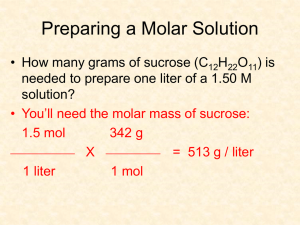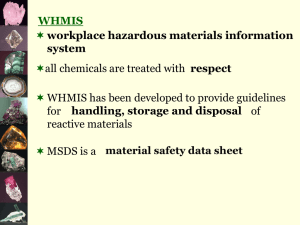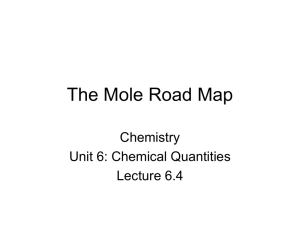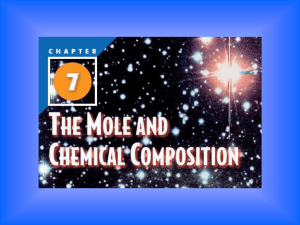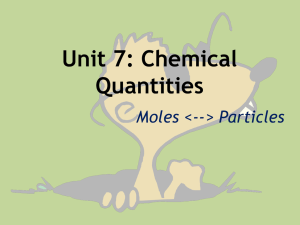normality
advertisement
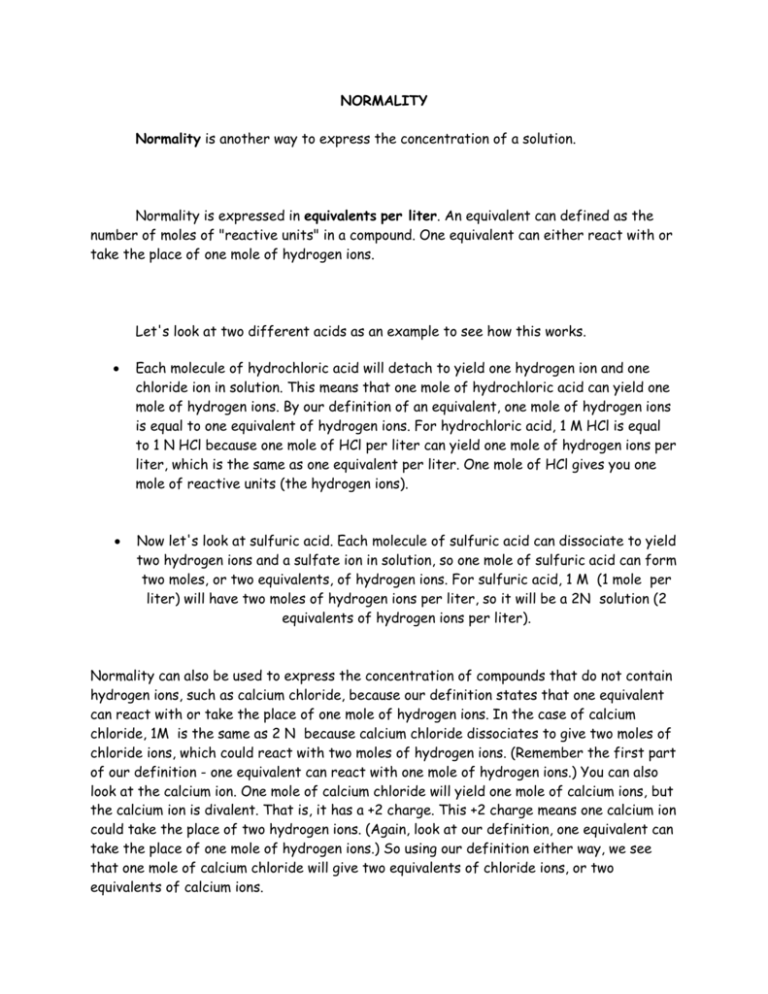
NORMALITY Normality is another way to express the concentration of a solution. Normality is expressed in equivalents per liter. An equivalent can defined as the number of moles of "reactive units" in a compound. One equivalent can either react with or take the place of one mole of hydrogen ions. Let's look at two different acids as an example to see how this works. Each molecule of hydrochloric acid will detach to yield one hydrogen ion and one chloride ion in solution. This means that one mole of hydrochloric acid can yield one mole of hydrogen ions. By our definition of an equivalent, one mole of hydrogen ions is equal to one equivalent of hydrogen ions. For hydrochloric acid, 1 M HCl is equal to 1 N HCl because one mole of HCl per liter can yield one mole of hydrogen ions per liter, which is the same as one equivalent per liter. One mole of HCl gives you one mole of reactive units (the hydrogen ions). Now let's look at sulfuric acid. Each molecule of sulfuric acid can dissociate to yield two hydrogen ions and a sulfate ion in solution, so one mole of sulfuric acid can form two moles, or two equivalents, of hydrogen ions. For sulfuric acid, 1 M (1 mole per liter) will have two moles of hydrogen ions per liter, so it will be a 2N solution (2 equivalents of hydrogen ions per liter). Normality can also be used to express the concentration of compounds that do not contain hydrogen ions, such as calcium chloride, because our definition states that one equivalent can react with or take the place of one mole of hydrogen ions. In the case of calcium chloride, 1M is the same as 2 N because calcium chloride dissociates to give two moles of chloride ions, which could react with two moles of hydrogen ions. (Remember the first part of our definition - one equivalent can react with one mole of hydrogen ions.) You can also look at the calcium ion. One mole of calcium chloride will yield one mole of calcium ions, but the calcium ion is divalent. That is, it has a +2 charge. This +2 charge means one calcium ion could take the place of two hydrogen ions. (Again, look at our definition, one equivalent can take the place of one mole of hydrogen ions.) So using our definition either way, we see that one mole of calcium chloride will give two equivalents of chloride ions, or two equivalents of calcium ions. We can use the relationship between molarity and normality to do the same types of calculations that we did for molarity. EXAMPLE : Example Find the normality of the solution containing 5.300 g/L of Na2CO3 (FW = 105.99), carbonate reacts with two protons. Solution Normality is the number of equivalents per liter, therefore we first find the number of equivalents eq wt = FW/2 = 105.99/2 = 53.00 eq = Wt/eq wt = 5.300/53.00 = 0.1000 N = eq/L = 0.1000 eq/1L = 0.1000 N The problem can be worked out simply as below ? eq Na2CO3 /L = (5.300 g Na2CO3 /L ) x (1 mol Na2CO3 /105.99 g Na2CO3 ) x (2 eq Na2CO3 /1 mol Na2CO3) = 0.1 N The other choice is to find the molarity first and the convert it to normality using the relation N = n M No of mol = 5.300 g/(105.99 g/mol) M = mol/L = [5.300 g/(105.99 g/mol)]/ 1L N = n M = 2 x [5.300 g/(105.99 g/mol)]/ 1L = 0.1000 A further option is to find the number of moles first followed by multiplying the result by 2 to obtain the number of equivalents. Example Find the normality of the solution containing 5.267 g/L K2Cr2O7 (FW = 294.19) if Cr6+ is reduced to Cr3+. Solution The same as the previous example N = eq/L, therefore we should find the number of eq where eq = wt/eq wt, therefore we should find the equivalent weight; where eq wt = FW/n. Here; each Contributes three electrons and since the dichromate contains two Cr atoms we have 6 reacting units Eq wt = (294.19 g/mol)/(6 eq/mol) Eq = 5.267 g/ (294.19 g/mol)/(6 eq/mol) N = eq/L = (294.19 g/mol)/(6 eq/mol)/1L = 0.1074 eq/L Using the dimensional analysis we may write ? eq K2Cr2O7 /L = (5.267 g K2Cr2O7 /L) x (mol K2Cr2O7 /294.19 g K2Cr2O7 ) x (6 eq K2Cr2O7 /mol K2Cr2O7 ) = 0.1074 eq/L Again one can choose to calculate the molarity then convert it to normality mol = 5.267 g/(294.19 g/mol) M = mol/L = [5.267 g/(294.19 g/mol)]/L N=nM N = (6 eq/mol)x [5.267 g/(294.19 g/mol)]/L = 0.1074 eq/L LET’S CHECK YOUR UNDERSTANDING !!!!!!! Determine the normality of : 1.5 M HNO3 0.55 M H2SO4 0.0023 M Ca(OH)2 REFERENCE: CHEMISTRY NOTEBOOK http://dwb4.unl.edu/Chem/CHEM869R/CHEM869RLinks/www.utmem.edu/allied/Solution s/Normality.html http://iweb.tntech.edu/bjackson/Chem1210/Notes/Lecture8.htm http://www.aug.edu/~chmsam/Chemistry2810/NormalityProblems.htm

